Business & Business Environment Report
VerifiedAdded on 2020/12/10
|15
|4448
|499
Report
AI Summary
This report examines the business environment, analyzing different types of organizations, their size and scope, and the interrelationship between organizational functions. It further explores the impact of macro-environmental factors on businesses using PESTLE and SWOT analysis, taking Marks & Spencer and Next Plc as case studies. The report concludes by emphasizing the importance of understanding and adapting to the dynamic business environment for organizational success.
Contribute Materials
Your contribution can guide someone’s learning journey. Share your
documents today.
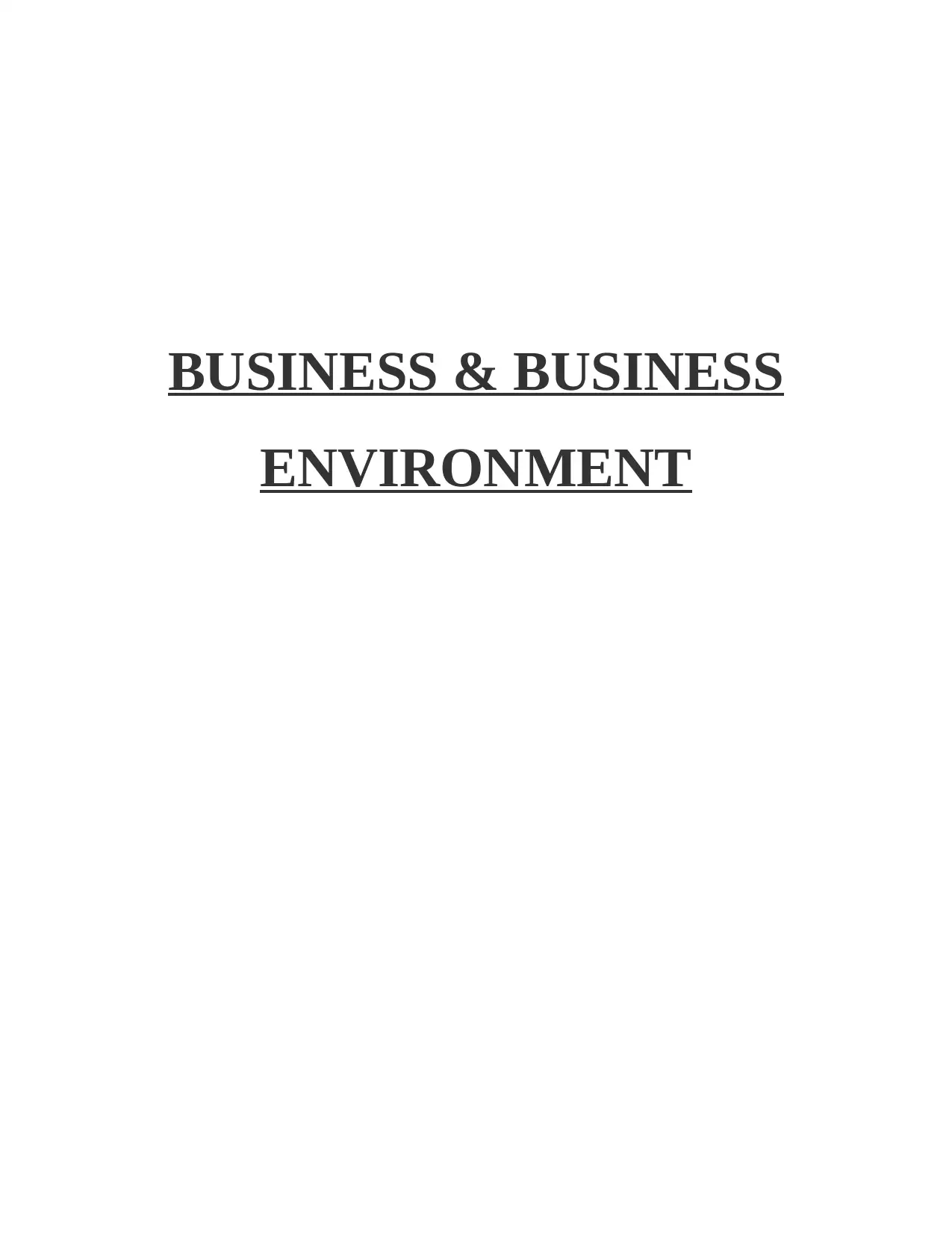
BUSINESS & BUSINESS
ENVIRONMENT
ENVIRONMENT
Secure Best Marks with AI Grader
Need help grading? Try our AI Grader for instant feedback on your assignments.
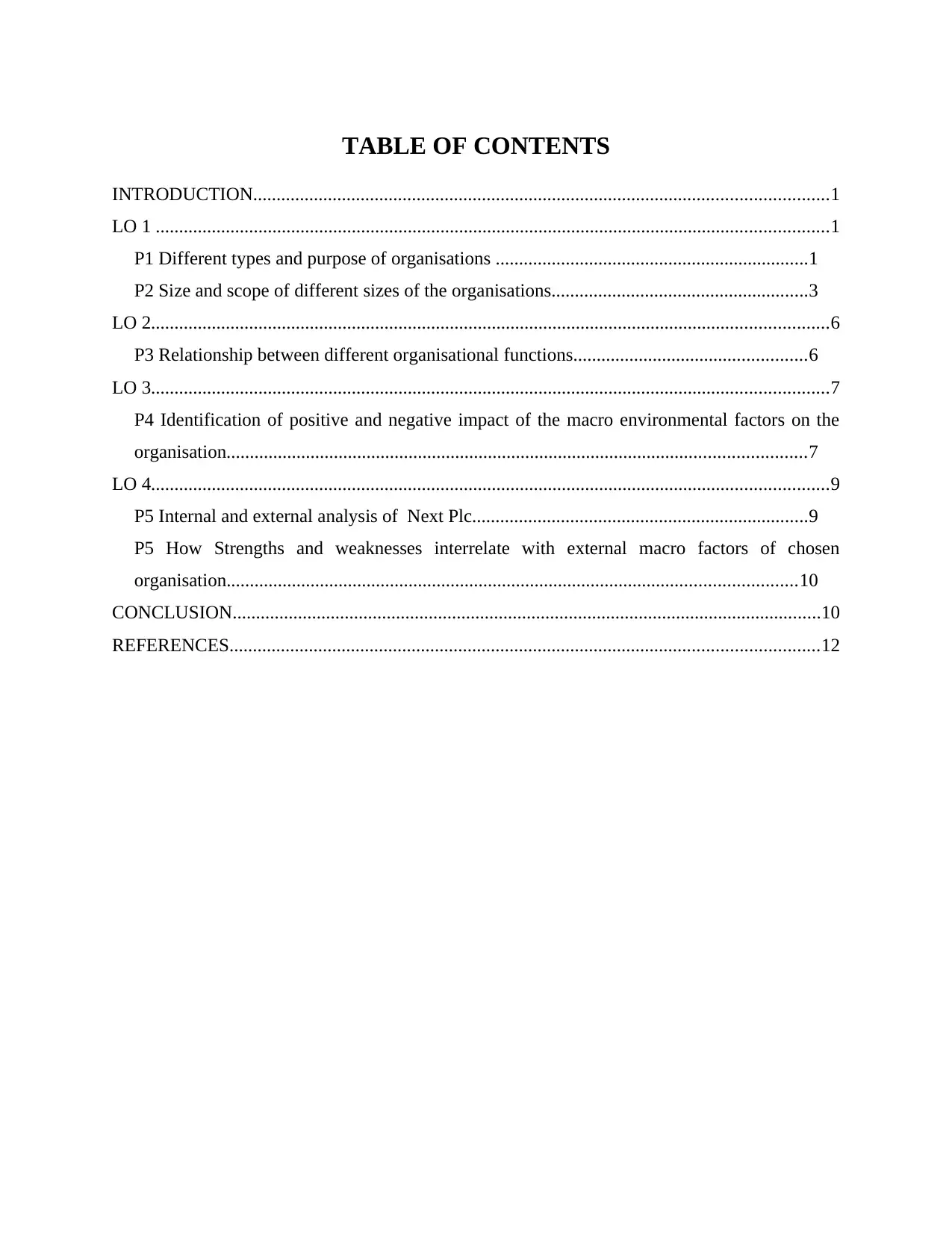
TABLE OF CONTENTS
INTRODUCTION...........................................................................................................................1
LO 1 ................................................................................................................................................1
P1 Different types and purpose of organisations ...................................................................1
P2 Size and scope of different sizes of the organisations.......................................................3
LO 2.................................................................................................................................................6
P3 Relationship between different organisational functions..................................................6
LO 3.................................................................................................................................................7
P4 Identification of positive and negative impact of the macro environmental factors on the
organisation............................................................................................................................7
LO 4.................................................................................................................................................9
P5 Internal and external analysis of Next Plc........................................................................9
P5 How Strengths and weaknesses interrelate with external macro factors of chosen
organisation..........................................................................................................................10
CONCLUSION..............................................................................................................................10
REFERENCES..............................................................................................................................12
INTRODUCTION...........................................................................................................................1
LO 1 ................................................................................................................................................1
P1 Different types and purpose of organisations ...................................................................1
P2 Size and scope of different sizes of the organisations.......................................................3
LO 2.................................................................................................................................................6
P3 Relationship between different organisational functions..................................................6
LO 3.................................................................................................................................................7
P4 Identification of positive and negative impact of the macro environmental factors on the
organisation............................................................................................................................7
LO 4.................................................................................................................................................9
P5 Internal and external analysis of Next Plc........................................................................9
P5 How Strengths and weaknesses interrelate with external macro factors of chosen
organisation..........................................................................................................................10
CONCLUSION..............................................................................................................................10
REFERENCES..............................................................................................................................12
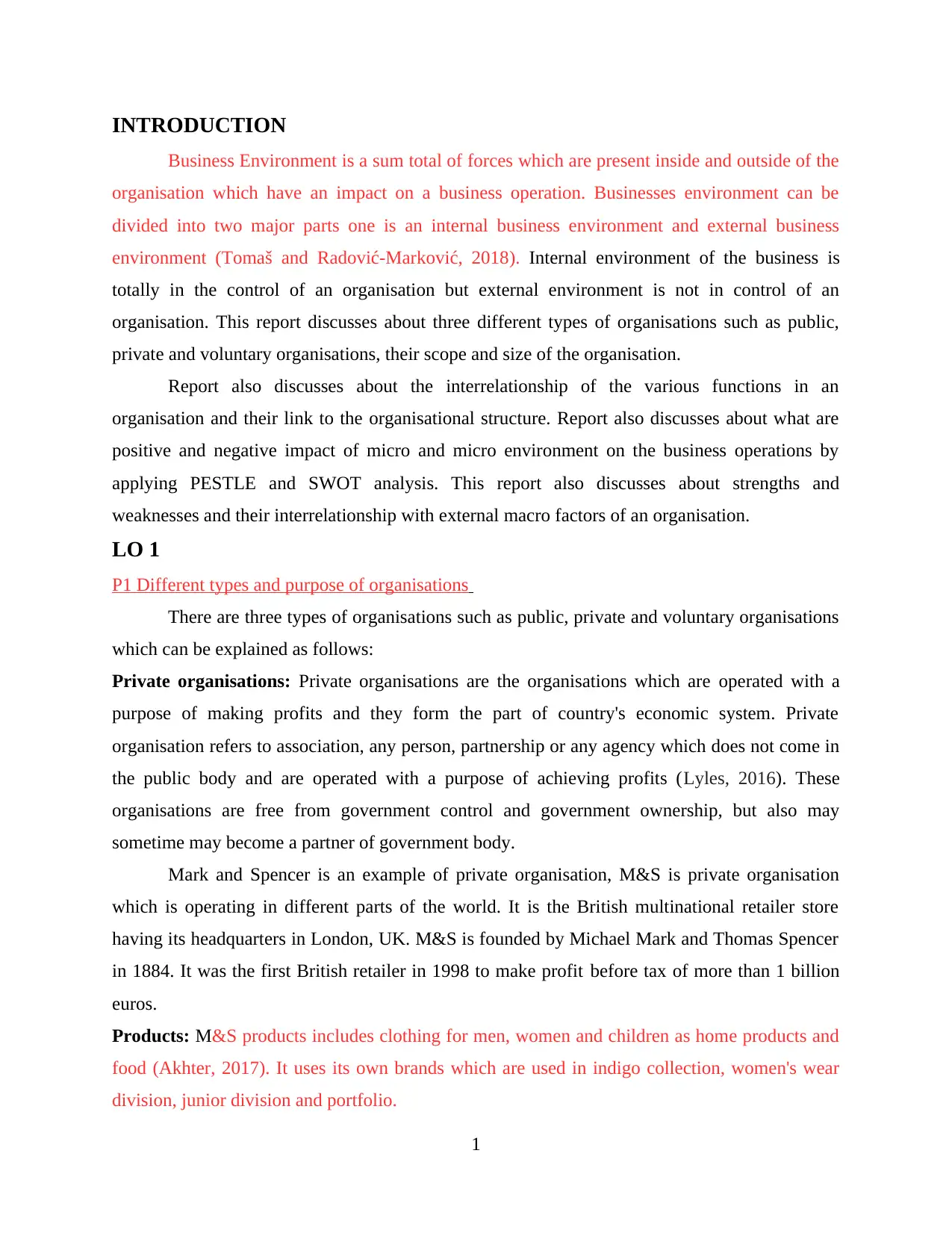
INTRODUCTION
Business Environment is a sum total of forces which are present inside and outside of the
organisation which have an impact on a business operation. Businesses environment can be
divided into two major parts one is an internal business environment and external business
environment (Tomaš and Radović-Marković, 2018). Internal environment of the business is
totally in the control of an organisation but external environment is not in control of an
organisation. This report discusses about three different types of organisations such as public,
private and voluntary organisations, their scope and size of the organisation.
Report also discusses about the interrelationship of the various functions in an
organisation and their link to the organisational structure. Report also discusses about what are
positive and negative impact of micro and micro environment on the business operations by
applying PESTLE and SWOT analysis. This report also discusses about strengths and
weaknesses and their interrelationship with external macro factors of an organisation.
LO 1
P1 Different types and purpose of organisations
There are three types of organisations such as public, private and voluntary organisations
which can be explained as follows:
Private organisations: Private organisations are the organisations which are operated with a
purpose of making profits and they form the part of country's economic system. Private
organisation refers to association, any person, partnership or any agency which does not come in
the public body and are operated with a purpose of achieving profits (Lyles, 2016). These
organisations are free from government control and government ownership, but also may
sometime may become a partner of government body.
Mark and Spencer is an example of private organisation, M&S is private organisation
which is operating in different parts of the world. It is the British multinational retailer store
having its headquarters in London, UK. M&S is founded by Michael Mark and Thomas Spencer
in 1884. It was the first British retailer in 1998 to make profit before tax of more than 1 billion
euros.
Products: M&S products includes clothing for men, women and children as home products and
food (Akhter, 2017). It uses its own brands which are used in indigo collection, women's wear
division, junior division and portfolio.
1
Business Environment is a sum total of forces which are present inside and outside of the
organisation which have an impact on a business operation. Businesses environment can be
divided into two major parts one is an internal business environment and external business
environment (Tomaš and Radović-Marković, 2018). Internal environment of the business is
totally in the control of an organisation but external environment is not in control of an
organisation. This report discusses about three different types of organisations such as public,
private and voluntary organisations, their scope and size of the organisation.
Report also discusses about the interrelationship of the various functions in an
organisation and their link to the organisational structure. Report also discusses about what are
positive and negative impact of micro and micro environment on the business operations by
applying PESTLE and SWOT analysis. This report also discusses about strengths and
weaknesses and their interrelationship with external macro factors of an organisation.
LO 1
P1 Different types and purpose of organisations
There are three types of organisations such as public, private and voluntary organisations
which can be explained as follows:
Private organisations: Private organisations are the organisations which are operated with a
purpose of making profits and they form the part of country's economic system. Private
organisation refers to association, any person, partnership or any agency which does not come in
the public body and are operated with a purpose of achieving profits (Lyles, 2016). These
organisations are free from government control and government ownership, but also may
sometime may become a partner of government body.
Mark and Spencer is an example of private organisation, M&S is private organisation
which is operating in different parts of the world. It is the British multinational retailer store
having its headquarters in London, UK. M&S is founded by Michael Mark and Thomas Spencer
in 1884. It was the first British retailer in 1998 to make profit before tax of more than 1 billion
euros.
Products: M&S products includes clothing for men, women and children as home products and
food (Akhter, 2017). It uses its own brands which are used in indigo collection, women's wear
division, junior division and portfolio.
1
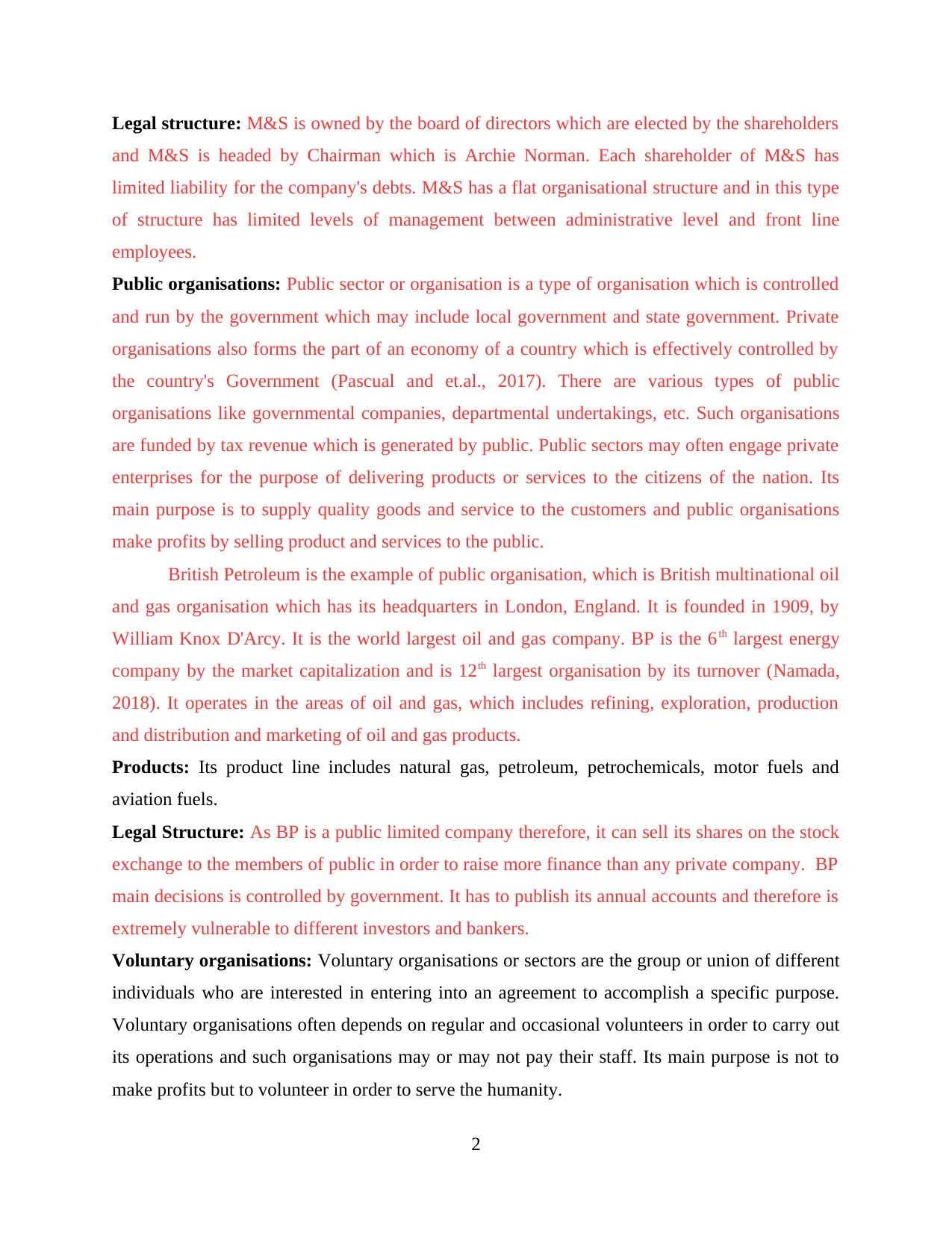
Legal structure: M&S is owned by the board of directors which are elected by the shareholders
and M&S is headed by Chairman which is Archie Norman. Each shareholder of M&S has
limited liability for the company's debts. M&S has a flat organisational structure and in this type
of structure has limited levels of management between administrative level and front line
employees.
Public organisations: Public sector or organisation is a type of organisation which is controlled
and run by the government which may include local government and state government. Private
organisations also forms the part of an economy of a country which is effectively controlled by
the country's Government (Pascual and et.al., 2017). There are various types of public
organisations like governmental companies, departmental undertakings, etc. Such organisations
are funded by tax revenue which is generated by public. Public sectors may often engage private
enterprises for the purpose of delivering products or services to the citizens of the nation. Its
main purpose is to supply quality goods and service to the customers and public organisations
make profits by selling product and services to the public.
British Petroleum is the example of public organisation, which is British multinational oil
and gas organisation which has its headquarters in London, England. It is founded in 1909, by
William Knox D'Arcy. It is the world largest oil and gas company. BP is the 6th largest energy
company by the market capitalization and is 12th largest organisation by its turnover (Namada,
2018). It operates in the areas of oil and gas, which includes refining, exploration, production
and distribution and marketing of oil and gas products.
Products: Its product line includes natural gas, petroleum, petrochemicals, motor fuels and
aviation fuels.
Legal Structure: As BP is a public limited company therefore, it can sell its shares on the stock
exchange to the members of public in order to raise more finance than any private company. BP
main decisions is controlled by government. It has to publish its annual accounts and therefore is
extremely vulnerable to different investors and bankers.
Voluntary organisations: Voluntary organisations or sectors are the group or union of different
individuals who are interested in entering into an agreement to accomplish a specific purpose.
Voluntary organisations often depends on regular and occasional volunteers in order to carry out
its operations and such organisations may or may not pay their staff. Its main purpose is not to
make profits but to volunteer in order to serve the humanity.
2
and M&S is headed by Chairman which is Archie Norman. Each shareholder of M&S has
limited liability for the company's debts. M&S has a flat organisational structure and in this type
of structure has limited levels of management between administrative level and front line
employees.
Public organisations: Public sector or organisation is a type of organisation which is controlled
and run by the government which may include local government and state government. Private
organisations also forms the part of an economy of a country which is effectively controlled by
the country's Government (Pascual and et.al., 2017). There are various types of public
organisations like governmental companies, departmental undertakings, etc. Such organisations
are funded by tax revenue which is generated by public. Public sectors may often engage private
enterprises for the purpose of delivering products or services to the citizens of the nation. Its
main purpose is to supply quality goods and service to the customers and public organisations
make profits by selling product and services to the public.
British Petroleum is the example of public organisation, which is British multinational oil
and gas organisation which has its headquarters in London, England. It is founded in 1909, by
William Knox D'Arcy. It is the world largest oil and gas company. BP is the 6th largest energy
company by the market capitalization and is 12th largest organisation by its turnover (Namada,
2018). It operates in the areas of oil and gas, which includes refining, exploration, production
and distribution and marketing of oil and gas products.
Products: Its product line includes natural gas, petroleum, petrochemicals, motor fuels and
aviation fuels.
Legal Structure: As BP is a public limited company therefore, it can sell its shares on the stock
exchange to the members of public in order to raise more finance than any private company. BP
main decisions is controlled by government. It has to publish its annual accounts and therefore is
extremely vulnerable to different investors and bankers.
Voluntary organisations: Voluntary organisations or sectors are the group or union of different
individuals who are interested in entering into an agreement to accomplish a specific purpose.
Voluntary organisations often depends on regular and occasional volunteers in order to carry out
its operations and such organisations may or may not pay their staff. Its main purpose is not to
make profits but to volunteer in order to serve the humanity.
2
Secure Best Marks with AI Grader
Need help grading? Try our AI Grader for instant feedback on your assignments.
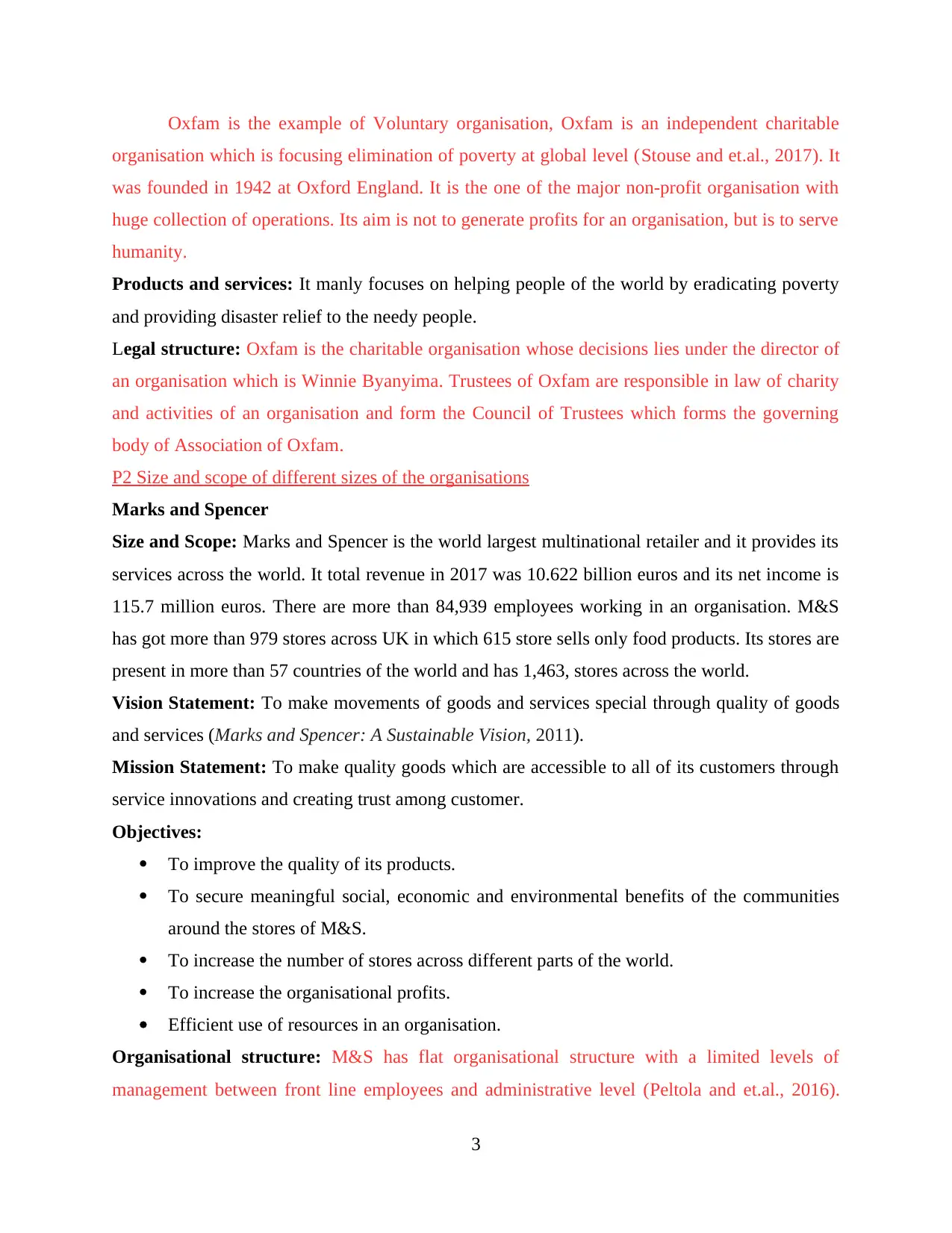
Oxfam is the example of Voluntary organisation, Oxfam is an independent charitable
organisation which is focusing elimination of poverty at global level (Stouse and et.al., 2017). It
was founded in 1942 at Oxford England. It is the one of the major non-profit organisation with
huge collection of operations. Its aim is not to generate profits for an organisation, but is to serve
humanity.
Products and services: It manly focuses on helping people of the world by eradicating poverty
and providing disaster relief to the needy people.
Legal structure: Oxfam is the charitable organisation whose decisions lies under the director of
an organisation which is Winnie Byanyima. Trustees of Oxfam are responsible in law of charity
and activities of an organisation and form the Council of Trustees which forms the governing
body of Association of Oxfam.
P2 Size and scope of different sizes of the organisations
Marks and Spencer
Size and Scope: Marks and Spencer is the world largest multinational retailer and it provides its
services across the world. It total revenue in 2017 was 10.622 billion euros and its net income is
115.7 million euros. There are more than 84,939 employees working in an organisation. M&S
has got more than 979 stores across UK in which 615 store sells only food products. Its stores are
present in more than 57 countries of the world and has 1,463, stores across the world.
Vision Statement: To make movements of goods and services special through quality of goods
and services (Marks and Spencer: A Sustainable Vision, 2011).
Mission Statement: To make quality goods which are accessible to all of its customers through
service innovations and creating trust among customer.
Objectives:
To improve the quality of its products.
To secure meaningful social, economic and environmental benefits of the communities
around the stores of M&S.
To increase the number of stores across different parts of the world.
To increase the organisational profits.
Efficient use of resources in an organisation.
Organisational structure: M&S has flat organisational structure with a limited levels of
management between front line employees and administrative level (Peltola and et.al., 2016).
3
organisation which is focusing elimination of poverty at global level (Stouse and et.al., 2017). It
was founded in 1942 at Oxford England. It is the one of the major non-profit organisation with
huge collection of operations. Its aim is not to generate profits for an organisation, but is to serve
humanity.
Products and services: It manly focuses on helping people of the world by eradicating poverty
and providing disaster relief to the needy people.
Legal structure: Oxfam is the charitable organisation whose decisions lies under the director of
an organisation which is Winnie Byanyima. Trustees of Oxfam are responsible in law of charity
and activities of an organisation and form the Council of Trustees which forms the governing
body of Association of Oxfam.
P2 Size and scope of different sizes of the organisations
Marks and Spencer
Size and Scope: Marks and Spencer is the world largest multinational retailer and it provides its
services across the world. It total revenue in 2017 was 10.622 billion euros and its net income is
115.7 million euros. There are more than 84,939 employees working in an organisation. M&S
has got more than 979 stores across UK in which 615 store sells only food products. Its stores are
present in more than 57 countries of the world and has 1,463, stores across the world.
Vision Statement: To make movements of goods and services special through quality of goods
and services (Marks and Spencer: A Sustainable Vision, 2011).
Mission Statement: To make quality goods which are accessible to all of its customers through
service innovations and creating trust among customer.
Objectives:
To improve the quality of its products.
To secure meaningful social, economic and environmental benefits of the communities
around the stores of M&S.
To increase the number of stores across different parts of the world.
To increase the organisational profits.
Efficient use of resources in an organisation.
Organisational structure: M&S has flat organisational structure with a limited levels of
management between front line employees and administrative level (Peltola and et.al., 2016).
3
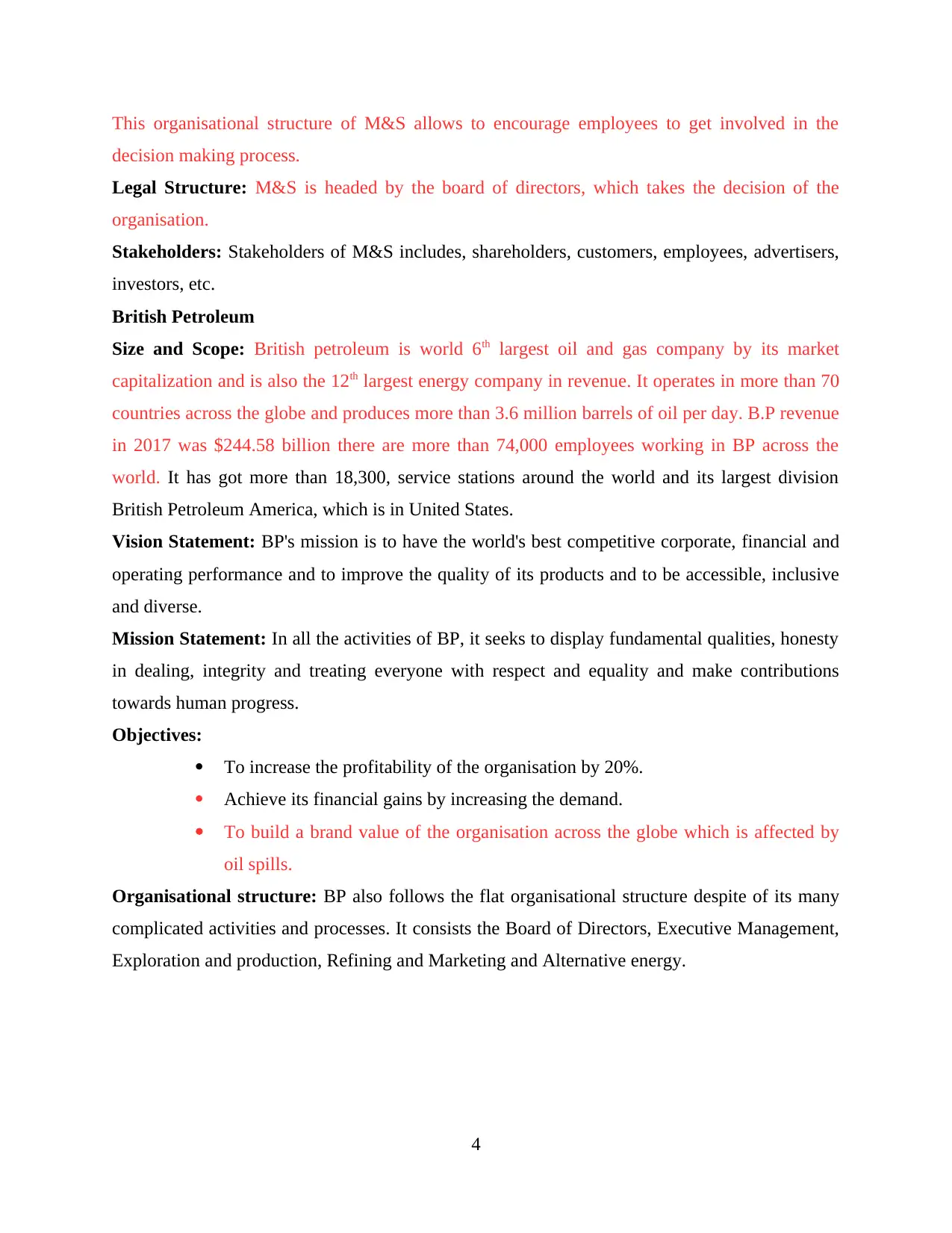
This organisational structure of M&S allows to encourage employees to get involved in the
decision making process.
Legal Structure: M&S is headed by the board of directors, which takes the decision of the
organisation.
Stakeholders: Stakeholders of M&S includes, shareholders, customers, employees, advertisers,
investors, etc.
British Petroleum
Size and Scope: British petroleum is world 6th largest oil and gas company by its market
capitalization and is also the 12th largest energy company in revenue. It operates in more than 70
countries across the globe and produces more than 3.6 million barrels of oil per day. B.P revenue
in 2017 was $244.58 billion there are more than 74,000 employees working in BP across the
world. It has got more than 18,300, service stations around the world and its largest division
British Petroleum America, which is in United States.
Vision Statement: BP's mission is to have the world's best competitive corporate, financial and
operating performance and to improve the quality of its products and to be accessible, inclusive
and diverse.
Mission Statement: In all the activities of BP, it seeks to display fundamental qualities, honesty
in dealing, integrity and treating everyone with respect and equality and make contributions
towards human progress.
Objectives:
To increase the profitability of the organisation by 20%.
Achieve its financial gains by increasing the demand.
To build a brand value of the organisation across the globe which is affected by
oil spills.
Organisational structure: BP also follows the flat organisational structure despite of its many
complicated activities and processes. It consists the Board of Directors, Executive Management,
Exploration and production, Refining and Marketing and Alternative energy.
4
decision making process.
Legal Structure: M&S is headed by the board of directors, which takes the decision of the
organisation.
Stakeholders: Stakeholders of M&S includes, shareholders, customers, employees, advertisers,
investors, etc.
British Petroleum
Size and Scope: British petroleum is world 6th largest oil and gas company by its market
capitalization and is also the 12th largest energy company in revenue. It operates in more than 70
countries across the globe and produces more than 3.6 million barrels of oil per day. B.P revenue
in 2017 was $244.58 billion there are more than 74,000 employees working in BP across the
world. It has got more than 18,300, service stations around the world and its largest division
British Petroleum America, which is in United States.
Vision Statement: BP's mission is to have the world's best competitive corporate, financial and
operating performance and to improve the quality of its products and to be accessible, inclusive
and diverse.
Mission Statement: In all the activities of BP, it seeks to display fundamental qualities, honesty
in dealing, integrity and treating everyone with respect and equality and make contributions
towards human progress.
Objectives:
To increase the profitability of the organisation by 20%.
Achieve its financial gains by increasing the demand.
To build a brand value of the organisation across the globe which is affected by
oil spills.
Organisational structure: BP also follows the flat organisational structure despite of its many
complicated activities and processes. It consists the Board of Directors, Executive Management,
Exploration and production, Refining and Marketing and Alternative energy.
4
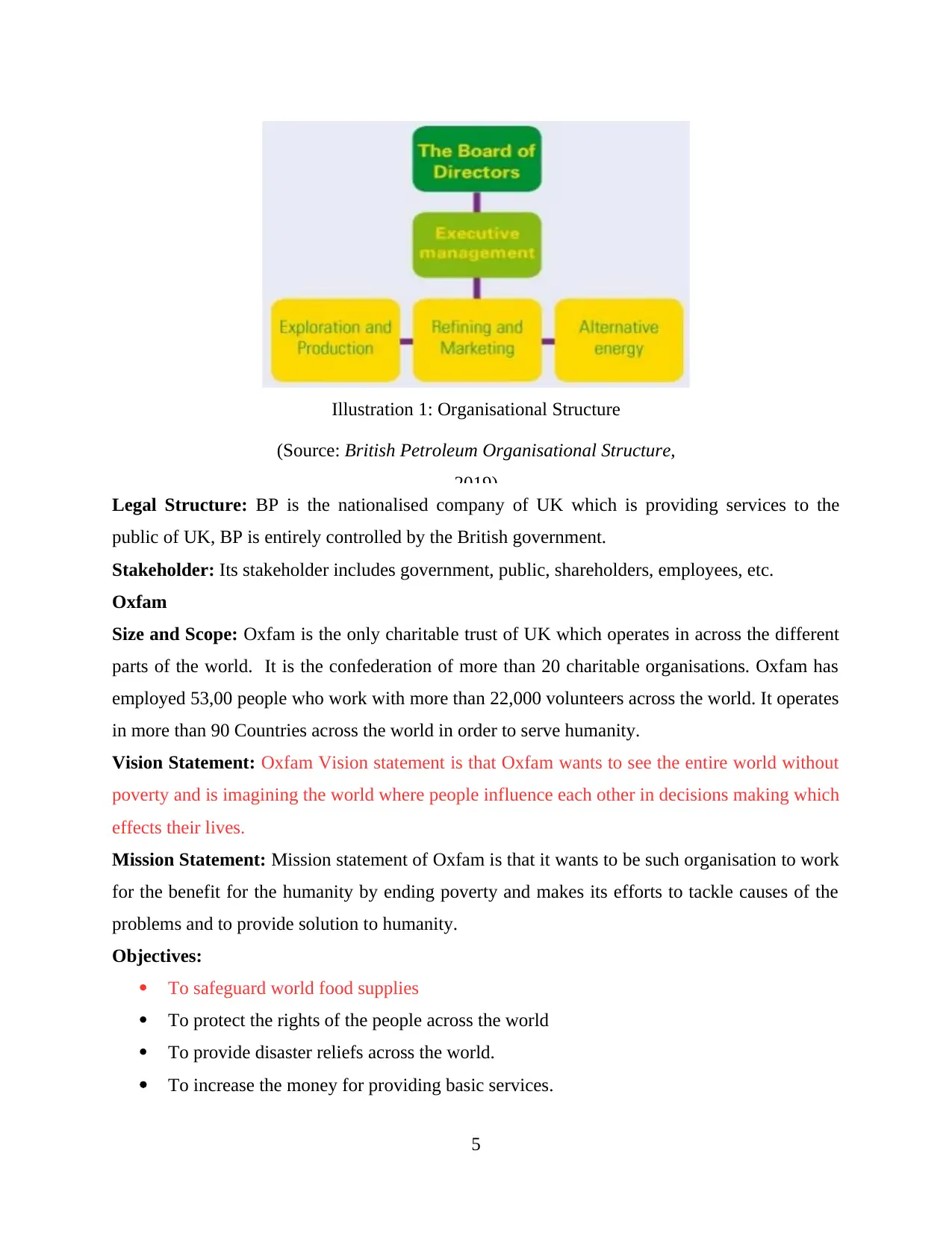
Illustration 1: Organisational Structure
(Source: British Petroleum Organisational Structure,
2019)
Legal Structure: BP is the nationalised company of UK which is providing services to the
public of UK, BP is entirely controlled by the British government.
Stakeholder: Its stakeholder includes government, public, shareholders, employees, etc.
Oxfam
Size and Scope: Oxfam is the only charitable trust of UK which operates in across the different
parts of the world. It is the confederation of more than 20 charitable organisations. Oxfam has
employed 53,00 people who work with more than 22,000 volunteers across the world. It operates
in more than 90 Countries across the world in order to serve humanity.
Vision Statement: Oxfam Vision statement is that Oxfam wants to see the entire world without
poverty and is imagining the world where people influence each other in decisions making which
effects their lives.
Mission Statement: Mission statement of Oxfam is that it wants to be such organisation to work
for the benefit for the humanity by ending poverty and makes its efforts to tackle causes of the
problems and to provide solution to humanity.
Objectives:
To safeguard world food supplies
To protect the rights of the people across the world
To provide disaster reliefs across the world.
To increase the money for providing basic services.
5
(Source: British Petroleum Organisational Structure,
2019)
Legal Structure: BP is the nationalised company of UK which is providing services to the
public of UK, BP is entirely controlled by the British government.
Stakeholder: Its stakeholder includes government, public, shareholders, employees, etc.
Oxfam
Size and Scope: Oxfam is the only charitable trust of UK which operates in across the different
parts of the world. It is the confederation of more than 20 charitable organisations. Oxfam has
employed 53,00 people who work with more than 22,000 volunteers across the world. It operates
in more than 90 Countries across the world in order to serve humanity.
Vision Statement: Oxfam Vision statement is that Oxfam wants to see the entire world without
poverty and is imagining the world where people influence each other in decisions making which
effects their lives.
Mission Statement: Mission statement of Oxfam is that it wants to be such organisation to work
for the benefit for the humanity by ending poverty and makes its efforts to tackle causes of the
problems and to provide solution to humanity.
Objectives:
To safeguard world food supplies
To protect the rights of the people across the world
To provide disaster reliefs across the world.
To increase the money for providing basic services.
5
Paraphrase This Document
Need a fresh take? Get an instant paraphrase of this document with our AI Paraphraser
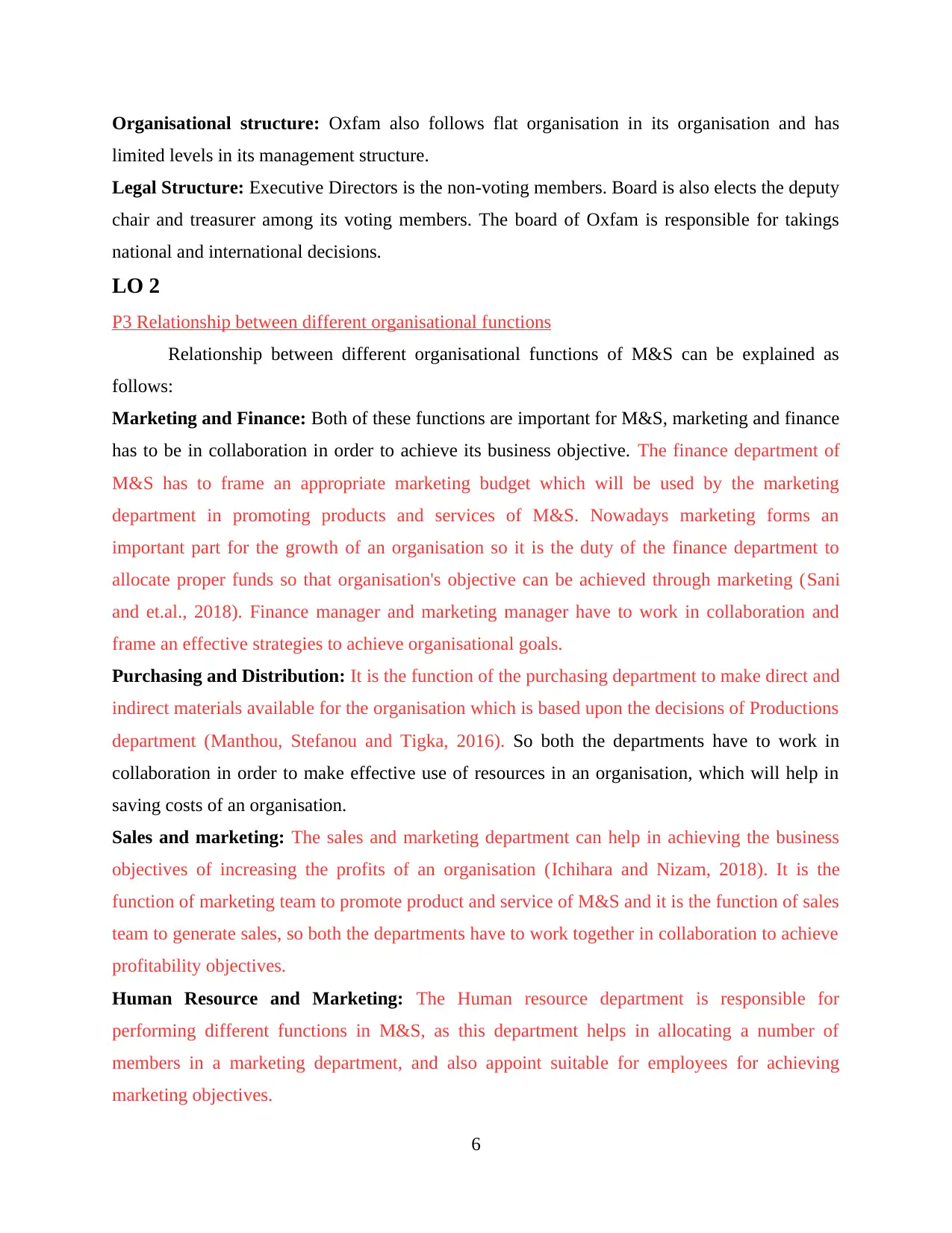
Organisational structure: Oxfam also follows flat organisation in its organisation and has
limited levels in its management structure.
Legal Structure: Executive Directors is the non-voting members. Board is also elects the deputy
chair and treasurer among its voting members. The board of Oxfam is responsible for takings
national and international decisions.
LO 2
P3 Relationship between different organisational functions
Relationship between different organisational functions of M&S can be explained as
follows:
Marketing and Finance: Both of these functions are important for M&S, marketing and finance
has to be in collaboration in order to achieve its business objective. The finance department of
M&S has to frame an appropriate marketing budget which will be used by the marketing
department in promoting products and services of M&S. Nowadays marketing forms an
important part for the growth of an organisation so it is the duty of the finance department to
allocate proper funds so that organisation's objective can be achieved through marketing (Sani
and et.al., 2018). Finance manager and marketing manager have to work in collaboration and
frame an effective strategies to achieve organisational goals.
Purchasing and Distribution: It is the function of the purchasing department to make direct and
indirect materials available for the organisation which is based upon the decisions of Productions
department (Manthou, Stefanou and Tigka, 2016). So both the departments have to work in
collaboration in order to make effective use of resources in an organisation, which will help in
saving costs of an organisation.
Sales and marketing: The sales and marketing department can help in achieving the business
objectives of increasing the profits of an organisation (Ichihara and Nizam, 2018). It is the
function of marketing team to promote product and service of M&S and it is the function of sales
team to generate sales, so both the departments have to work together in collaboration to achieve
profitability objectives.
Human Resource and Marketing: The Human resource department is responsible for
performing different functions in M&S, as this department helps in allocating a number of
members in a marketing department, and also appoint suitable for employees for achieving
marketing objectives.
6
limited levels in its management structure.
Legal Structure: Executive Directors is the non-voting members. Board is also elects the deputy
chair and treasurer among its voting members. The board of Oxfam is responsible for takings
national and international decisions.
LO 2
P3 Relationship between different organisational functions
Relationship between different organisational functions of M&S can be explained as
follows:
Marketing and Finance: Both of these functions are important for M&S, marketing and finance
has to be in collaboration in order to achieve its business objective. The finance department of
M&S has to frame an appropriate marketing budget which will be used by the marketing
department in promoting products and services of M&S. Nowadays marketing forms an
important part for the growth of an organisation so it is the duty of the finance department to
allocate proper funds so that organisation's objective can be achieved through marketing (Sani
and et.al., 2018). Finance manager and marketing manager have to work in collaboration and
frame an effective strategies to achieve organisational goals.
Purchasing and Distribution: It is the function of the purchasing department to make direct and
indirect materials available for the organisation which is based upon the decisions of Productions
department (Manthou, Stefanou and Tigka, 2016). So both the departments have to work in
collaboration in order to make effective use of resources in an organisation, which will help in
saving costs of an organisation.
Sales and marketing: The sales and marketing department can help in achieving the business
objectives of increasing the profits of an organisation (Ichihara and Nizam, 2018). It is the
function of marketing team to promote product and service of M&S and it is the function of sales
team to generate sales, so both the departments have to work together in collaboration to achieve
profitability objectives.
Human Resource and Marketing: The Human resource department is responsible for
performing different functions in M&S, as this department helps in allocating a number of
members in a marketing department, and also appoint suitable for employees for achieving
marketing objectives.
6
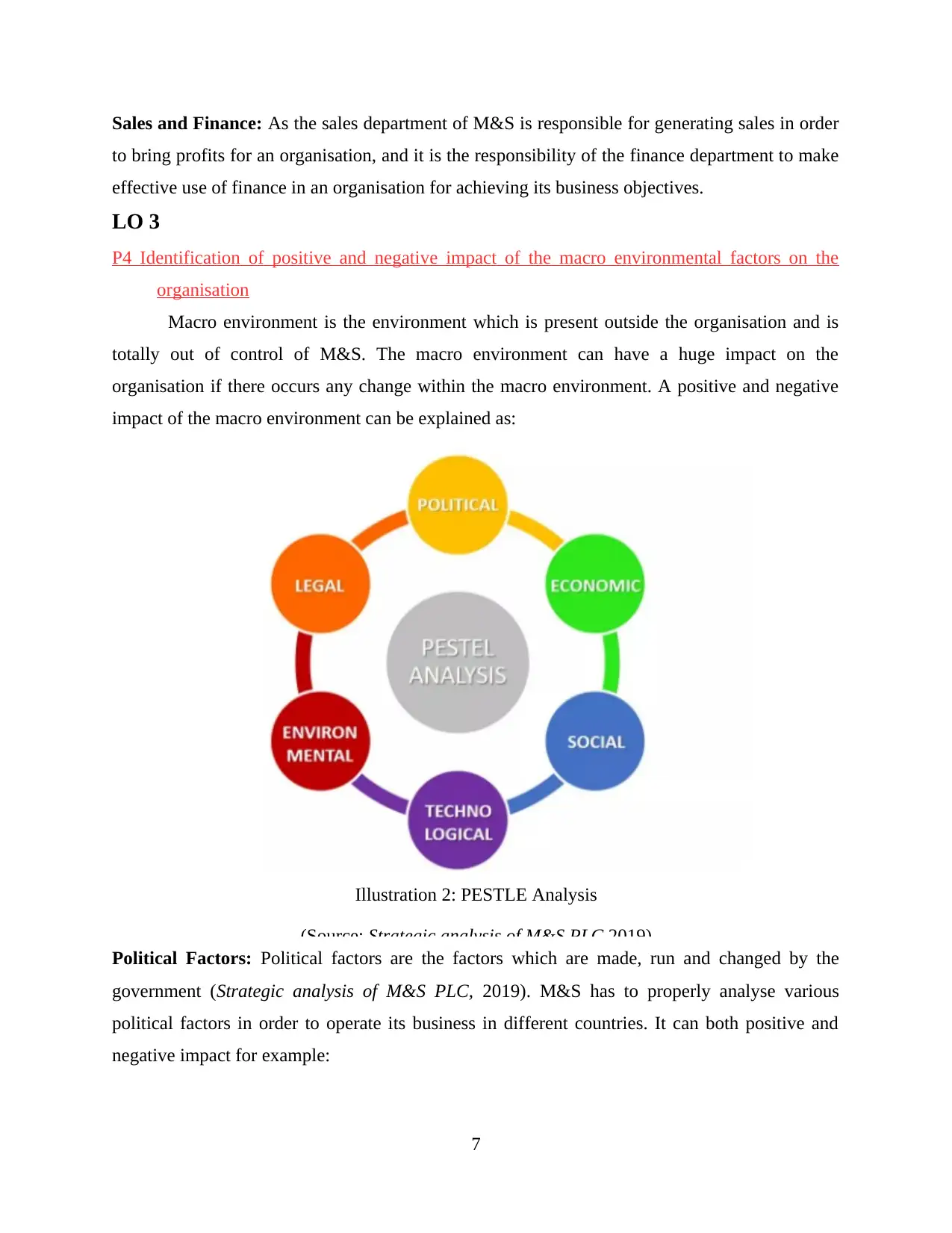
Sales and Finance: As the sales department of M&S is responsible for generating sales in order
to bring profits for an organisation, and it is the responsibility of the finance department to make
effective use of finance in an organisation for achieving its business objectives.
LO 3
P4 Identification of positive and negative impact of the macro environmental factors on the
organisation
Macro environment is the environment which is present outside the organisation and is
totally out of control of M&S. The macro environment can have a huge impact on the
organisation if there occurs any change within the macro environment. A positive and negative
impact of the macro environment can be explained as:
Illustration 2: PESTLE Analysis
(Source: Strategic analysis of M&S PLC,2019)
Political Factors: Political factors are the factors which are made, run and changed by the
government (Strategic analysis of M&S PLC, 2019). M&S has to properly analyse various
political factors in order to operate its business in different countries. It can both positive and
negative impact for example:
7
to bring profits for an organisation, and it is the responsibility of the finance department to make
effective use of finance in an organisation for achieving its business objectives.
LO 3
P4 Identification of positive and negative impact of the macro environmental factors on the
organisation
Macro environment is the environment which is present outside the organisation and is
totally out of control of M&S. The macro environment can have a huge impact on the
organisation if there occurs any change within the macro environment. A positive and negative
impact of the macro environment can be explained as:
Illustration 2: PESTLE Analysis
(Source: Strategic analysis of M&S PLC,2019)
Political Factors: Political factors are the factors which are made, run and changed by the
government (Strategic analysis of M&S PLC, 2019). M&S has to properly analyse various
political factors in order to operate its business in different countries. It can both positive and
negative impact for example:
7
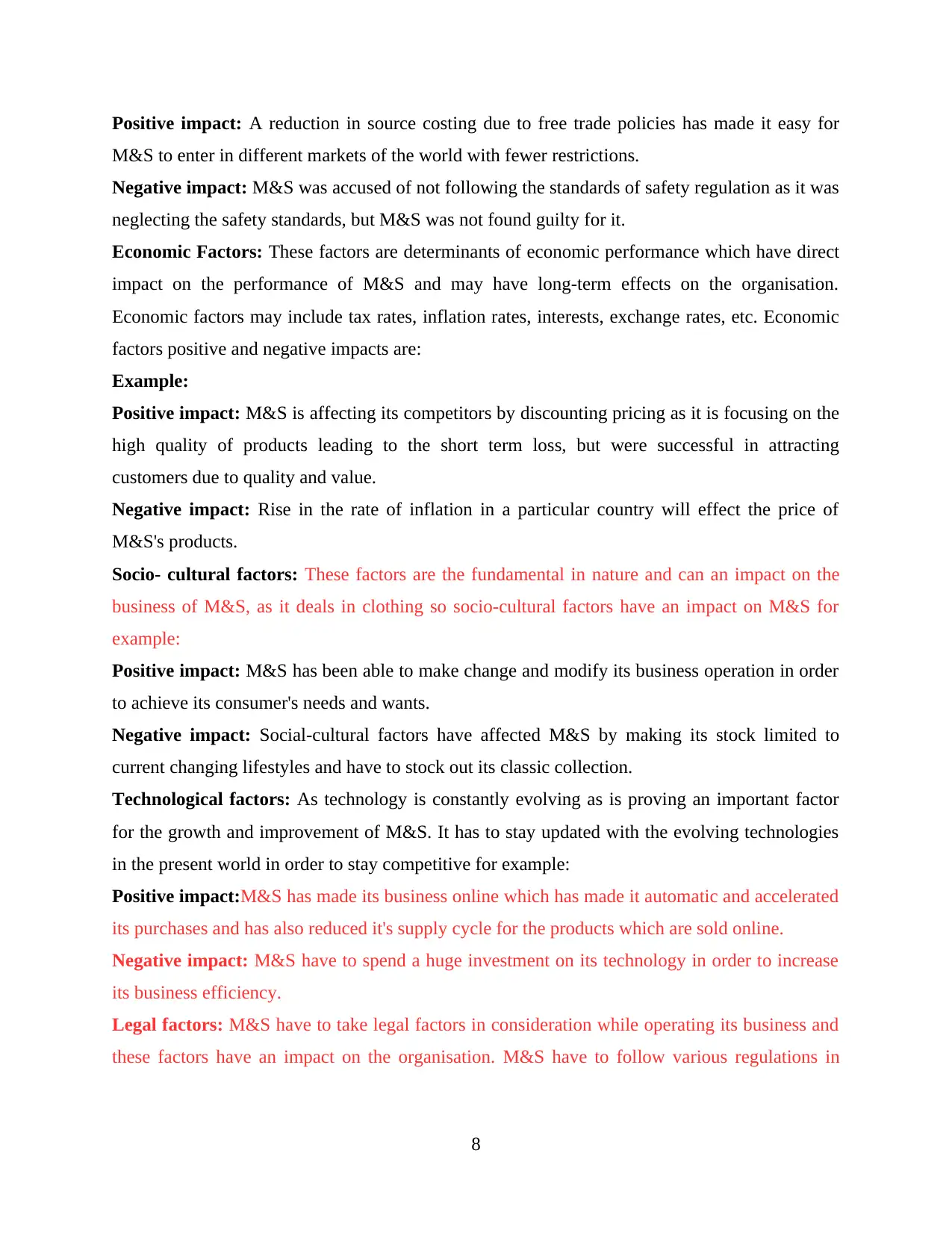
Positive impact: A reduction in source costing due to free trade policies has made it easy for
M&S to enter in different markets of the world with fewer restrictions.
Negative impact: M&S was accused of not following the standards of safety regulation as it was
neglecting the safety standards, but M&S was not found guilty for it.
Economic Factors: These factors are determinants of economic performance which have direct
impact on the performance of M&S and may have long-term effects on the organisation.
Economic factors may include tax rates, inflation rates, interests, exchange rates, etc. Economic
factors positive and negative impacts are:
Example:
Positive impact: M&S is affecting its competitors by discounting pricing as it is focusing on the
high quality of products leading to the short term loss, but were successful in attracting
customers due to quality and value.
Negative impact: Rise in the rate of inflation in a particular country will effect the price of
M&S's products.
Socio- cultural factors: These factors are the fundamental in nature and can an impact on the
business of M&S, as it deals in clothing so socio-cultural factors have an impact on M&S for
example:
Positive impact: M&S has been able to make change and modify its business operation in order
to achieve its consumer's needs and wants.
Negative impact: Social-cultural factors have affected M&S by making its stock limited to
current changing lifestyles and have to stock out its classic collection.
Technological factors: As technology is constantly evolving as is proving an important factor
for the growth and improvement of M&S. It has to stay updated with the evolving technologies
in the present world in order to stay competitive for example:
Positive impact:M&S has made its business online which has made it automatic and accelerated
its purchases and has also reduced it's supply cycle for the products which are sold online.
Negative impact: M&S have to spend a huge investment on its technology in order to increase
its business efficiency.
Legal factors: M&S have to take legal factors in consideration while operating its business and
these factors have an impact on the organisation. M&S have to follow various regulations in
8
M&S to enter in different markets of the world with fewer restrictions.
Negative impact: M&S was accused of not following the standards of safety regulation as it was
neglecting the safety standards, but M&S was not found guilty for it.
Economic Factors: These factors are determinants of economic performance which have direct
impact on the performance of M&S and may have long-term effects on the organisation.
Economic factors may include tax rates, inflation rates, interests, exchange rates, etc. Economic
factors positive and negative impacts are:
Example:
Positive impact: M&S is affecting its competitors by discounting pricing as it is focusing on the
high quality of products leading to the short term loss, but were successful in attracting
customers due to quality and value.
Negative impact: Rise in the rate of inflation in a particular country will effect the price of
M&S's products.
Socio- cultural factors: These factors are the fundamental in nature and can an impact on the
business of M&S, as it deals in clothing so socio-cultural factors have an impact on M&S for
example:
Positive impact: M&S has been able to make change and modify its business operation in order
to achieve its consumer's needs and wants.
Negative impact: Social-cultural factors have affected M&S by making its stock limited to
current changing lifestyles and have to stock out its classic collection.
Technological factors: As technology is constantly evolving as is proving an important factor
for the growth and improvement of M&S. It has to stay updated with the evolving technologies
in the present world in order to stay competitive for example:
Positive impact:M&S has made its business online which has made it automatic and accelerated
its purchases and has also reduced it's supply cycle for the products which are sold online.
Negative impact: M&S have to spend a huge investment on its technology in order to increase
its business efficiency.
Legal factors: M&S have to take legal factors in consideration while operating its business and
these factors have an impact on the organisation. M&S have to follow various regulations in
8
Secure Best Marks with AI Grader
Need help grading? Try our AI Grader for instant feedback on your assignments.
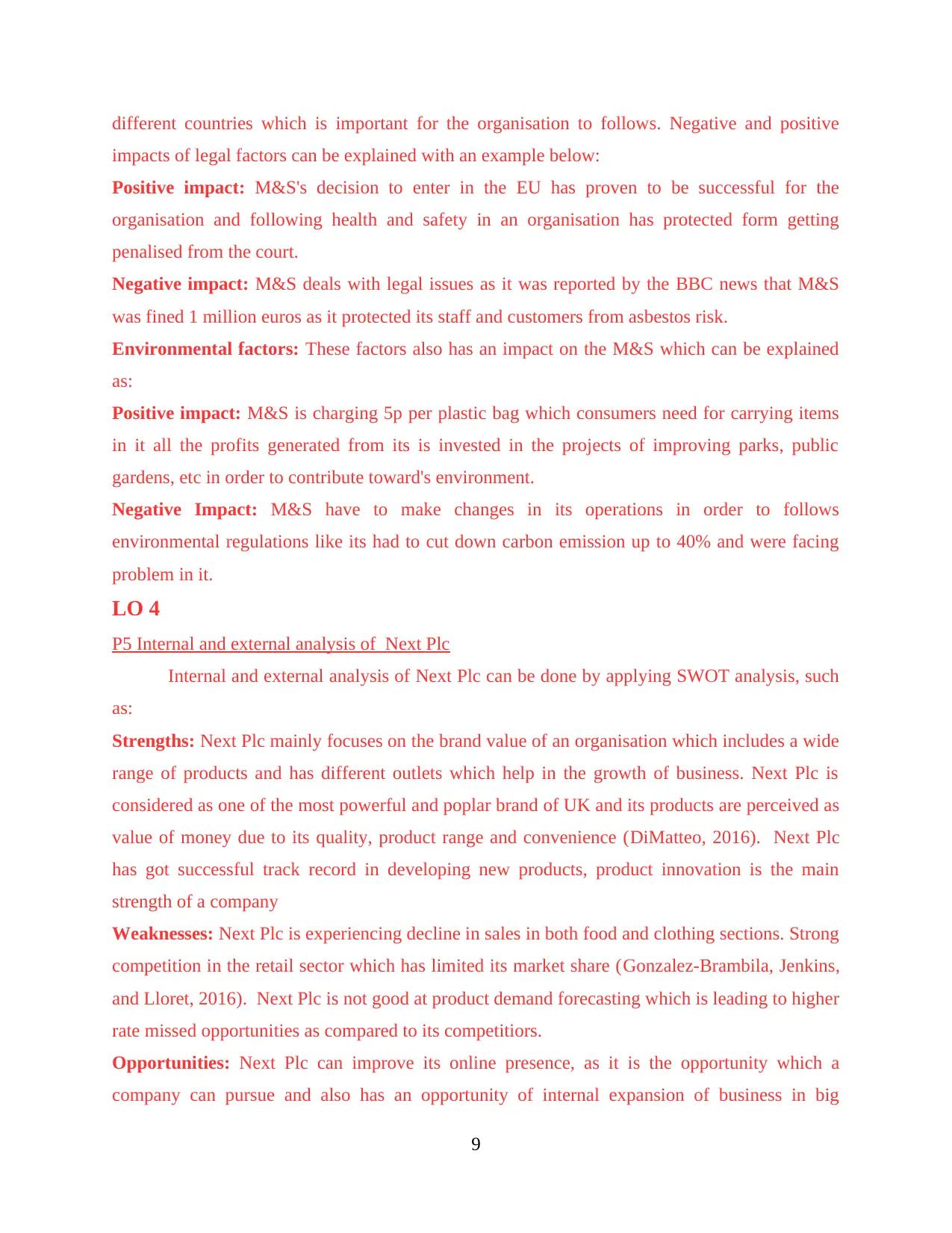
different countries which is important for the organisation to follows. Negative and positive
impacts of legal factors can be explained with an example below:
Positive impact: M&S's decision to enter in the EU has proven to be successful for the
organisation and following health and safety in an organisation has protected form getting
penalised from the court.
Negative impact: M&S deals with legal issues as it was reported by the BBC news that M&S
was fined 1 million euros as it protected its staff and customers from asbestos risk.
Environmental factors: These factors also has an impact on the M&S which can be explained
as:
Positive impact: M&S is charging 5p per plastic bag which consumers need for carrying items
in it all the profits generated from its is invested in the projects of improving parks, public
gardens, etc in order to contribute toward's environment.
Negative Impact: M&S have to make changes in its operations in order to follows
environmental regulations like its had to cut down carbon emission up to 40% and were facing
problem in it.
LO 4
P5 Internal and external analysis of Next Plc
Internal and external analysis of Next Plc can be done by applying SWOT analysis, such
as:
Strengths: Next Plc mainly focuses on the brand value of an organisation which includes a wide
range of products and has different outlets which help in the growth of business. Next Plc is
considered as one of the most powerful and poplar brand of UK and its products are perceived as
value of money due to its quality, product range and convenience (DiMatteo, 2016). Next Plc
has got successful track record in developing new products, product innovation is the main
strength of a company
Weaknesses: Next Plc is experiencing decline in sales in both food and clothing sections. Strong
competition in the retail sector which has limited its market share (Gonzalez-Brambila, Jenkins,
and Lloret, 2016). Next Plc is not good at product demand forecasting which is leading to higher
rate missed opportunities as compared to its competitiors.
Opportunities: Next Plc can improve its online presence, as it is the opportunity which a
company can pursue and also has an opportunity of internal expansion of business in big
9
impacts of legal factors can be explained with an example below:
Positive impact: M&S's decision to enter in the EU has proven to be successful for the
organisation and following health and safety in an organisation has protected form getting
penalised from the court.
Negative impact: M&S deals with legal issues as it was reported by the BBC news that M&S
was fined 1 million euros as it protected its staff and customers from asbestos risk.
Environmental factors: These factors also has an impact on the M&S which can be explained
as:
Positive impact: M&S is charging 5p per plastic bag which consumers need for carrying items
in it all the profits generated from its is invested in the projects of improving parks, public
gardens, etc in order to contribute toward's environment.
Negative Impact: M&S have to make changes in its operations in order to follows
environmental regulations like its had to cut down carbon emission up to 40% and were facing
problem in it.
LO 4
P5 Internal and external analysis of Next Plc
Internal and external analysis of Next Plc can be done by applying SWOT analysis, such
as:
Strengths: Next Plc mainly focuses on the brand value of an organisation which includes a wide
range of products and has different outlets which help in the growth of business. Next Plc is
considered as one of the most powerful and poplar brand of UK and its products are perceived as
value of money due to its quality, product range and convenience (DiMatteo, 2016). Next Plc
has got successful track record in developing new products, product innovation is the main
strength of a company
Weaknesses: Next Plc is experiencing decline in sales in both food and clothing sections. Strong
competition in the retail sector which has limited its market share (Gonzalez-Brambila, Jenkins,
and Lloret, 2016). Next Plc is not good at product demand forecasting which is leading to higher
rate missed opportunities as compared to its competitiors.
Opportunities: Next Plc can improve its online presence, as it is the opportunity which a
company can pursue and also has an opportunity of internal expansion of business in big
9
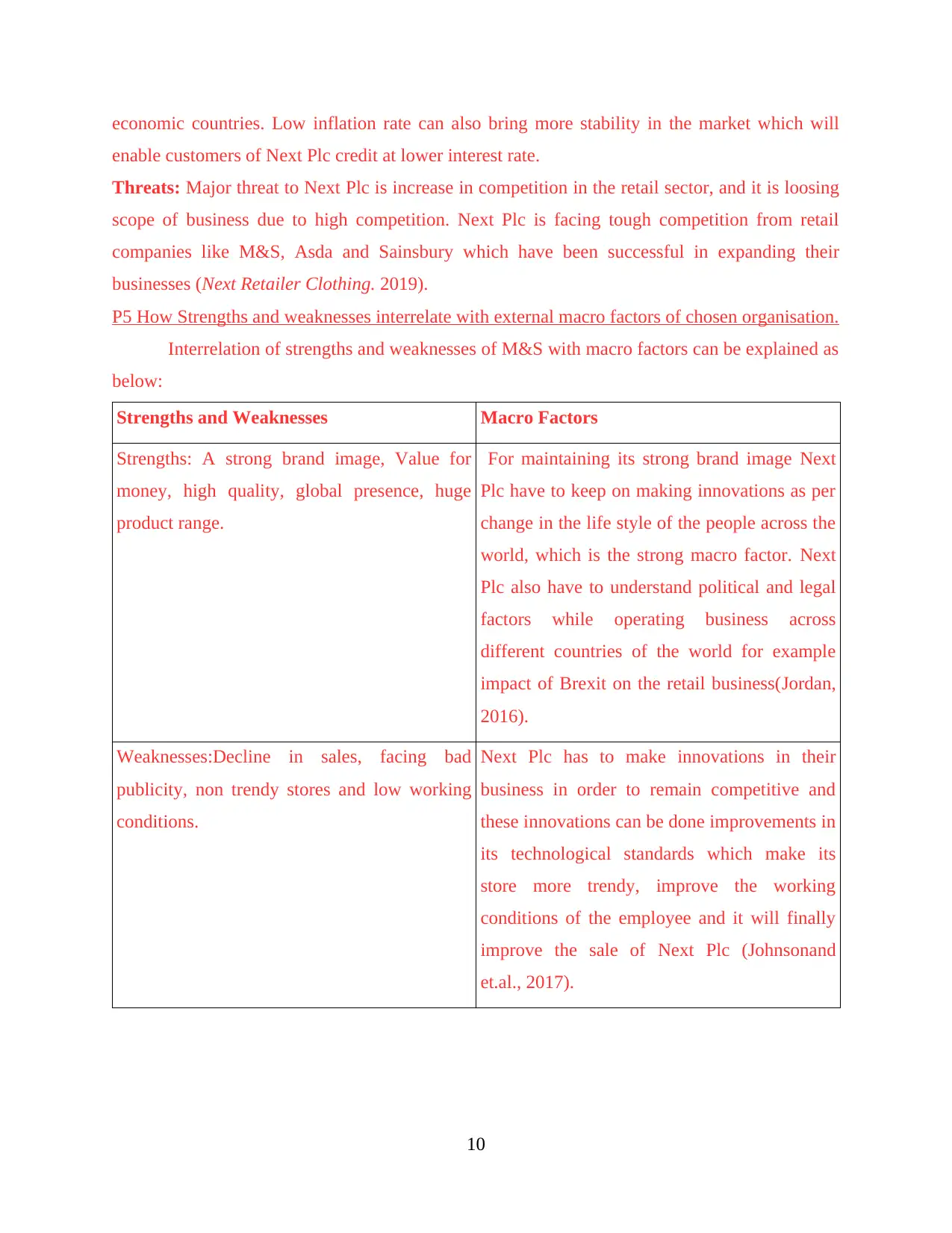
economic countries. Low inflation rate can also bring more stability in the market which will
enable customers of Next Plc credit at lower interest rate.
Threats: Major threat to Next Plc is increase in competition in the retail sector, and it is loosing
scope of business due to high competition. Next Plc is facing tough competition from retail
companies like M&S, Asda and Sainsbury which have been successful in expanding their
businesses (Next Retailer Clothing. 2019).
P5 How Strengths and weaknesses interrelate with external macro factors of chosen organisation.
Interrelation of strengths and weaknesses of M&S with macro factors can be explained as
below:
Strengths and Weaknesses Macro Factors
Strengths: A strong brand image, Value for
money, high quality, global presence, huge
product range.
For maintaining its strong brand image Next
Plc have to keep on making innovations as per
change in the life style of the people across the
world, which is the strong macro factor. Next
Plc also have to understand political and legal
factors while operating business across
different countries of the world for example
impact of Brexit on the retail business(Jordan,
2016).
Weaknesses:Decline in sales, facing bad
publicity, non trendy stores and low working
conditions.
Next Plc has to make innovations in their
business in order to remain competitive and
these innovations can be done improvements in
its technological standards which make its
store more trendy, improve the working
conditions of the employee and it will finally
improve the sale of Next Plc (Johnsonand
et.al., 2017).
10
enable customers of Next Plc credit at lower interest rate.
Threats: Major threat to Next Plc is increase in competition in the retail sector, and it is loosing
scope of business due to high competition. Next Plc is facing tough competition from retail
companies like M&S, Asda and Sainsbury which have been successful in expanding their
businesses (Next Retailer Clothing. 2019).
P5 How Strengths and weaknesses interrelate with external macro factors of chosen organisation.
Interrelation of strengths and weaknesses of M&S with macro factors can be explained as
below:
Strengths and Weaknesses Macro Factors
Strengths: A strong brand image, Value for
money, high quality, global presence, huge
product range.
For maintaining its strong brand image Next
Plc have to keep on making innovations as per
change in the life style of the people across the
world, which is the strong macro factor. Next
Plc also have to understand political and legal
factors while operating business across
different countries of the world for example
impact of Brexit on the retail business(Jordan,
2016).
Weaknesses:Decline in sales, facing bad
publicity, non trendy stores and low working
conditions.
Next Plc has to make innovations in their
business in order to remain competitive and
these innovations can be done improvements in
its technological standards which make its
store more trendy, improve the working
conditions of the employee and it will finally
improve the sale of Next Plc (Johnsonand
et.al., 2017).
10

CONCLUSION
It can be concluded that Business environment is important for organisational success as
it helps in making the analysis of forces which are present with the business and in this business
environment exists three types of organisations such as private, public, and voluntary
organisation which are different in size, culture, aims and objectives. Present report also
concludes that there is the relationship between different functions of an organisation and this
interrelationship can help an organisation in achieving objectives. It is concluded from this report
that macros environmental factors may have both positive and negative impact on the
organisation. It can also be concluded from the internal and external analysis of an organisation
that it has got various strengths and weaknesses as per internal analysis and has various
opportunities and threats as per its external analysis. An organisation has to maintain the
relationship between its strengths and weaknesses with micro factors in order to be successful in
business.
11
It can be concluded that Business environment is important for organisational success as
it helps in making the analysis of forces which are present with the business and in this business
environment exists three types of organisations such as private, public, and voluntary
organisation which are different in size, culture, aims and objectives. Present report also
concludes that there is the relationship between different functions of an organisation and this
interrelationship can help an organisation in achieving objectives. It is concluded from this report
that macros environmental factors may have both positive and negative impact on the
organisation. It can also be concluded from the internal and external analysis of an organisation
that it has got various strengths and weaknesses as per internal analysis and has various
opportunities and threats as per its external analysis. An organisation has to maintain the
relationship between its strengths and weaknesses with micro factors in order to be successful in
business.
11
Paraphrase This Document
Need a fresh take? Get an instant paraphrase of this document with our AI Paraphraser
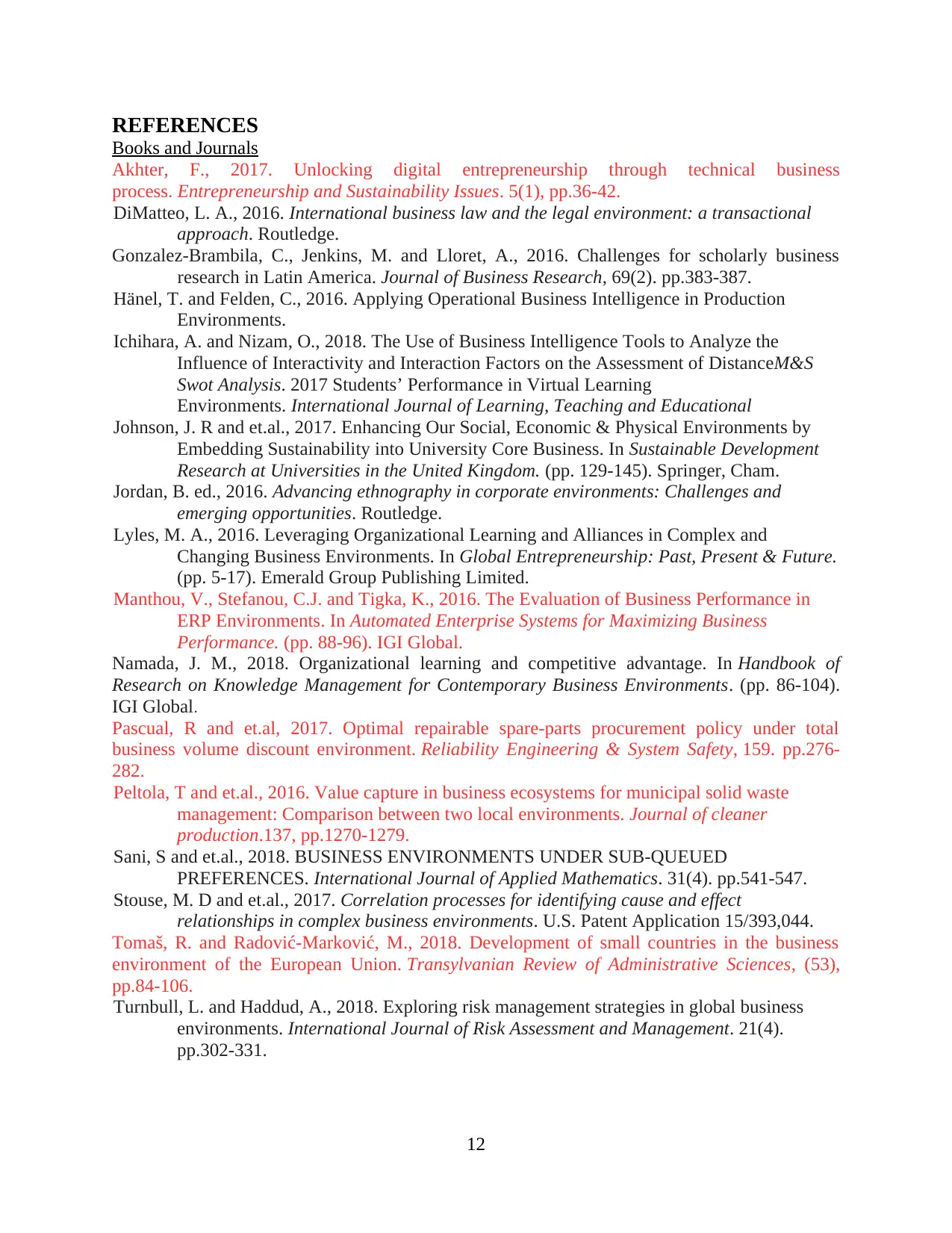
REFERENCES
Books and Journals
Akhter, F., 2017. Unlocking digital entrepreneurship through technical business
process. Entrepreneurship and Sustainability Issues. 5(1), pp.36-42.
DiMatteo, L. A., 2016. International business law and the legal environment: a transactional
approach. Routledge.
Gonzalez-Brambila, C., Jenkins, M. and Lloret, A., 2016. Challenges for scholarly business
research in Latin America. Journal of Business Research, 69(2). pp.383-387.
Hänel, T. and Felden, C., 2016. Applying Operational Business Intelligence in Production
Environments.
Ichihara, A. and Nizam, O., 2018. The Use of Business Intelligence Tools to Analyze the
Influence of Interactivity and Interaction Factors on the Assessment of DistanceM&S
Swot Analysis. 2017 Students’ Performance in Virtual Learning
Environments. International Journal of Learning, Teaching and Educational
Johnson, J. R and et.al., 2017. Enhancing Our Social, Economic & Physical Environments by
Embedding Sustainability into University Core Business. In Sustainable Development
Research at Universities in the United Kingdom. (pp. 129-145). Springer, Cham.
Jordan, B. ed., 2016. Advancing ethnography in corporate environments: Challenges and
emerging opportunities. Routledge.
Lyles, M. A., 2016. Leveraging Organizational Learning and Alliances in Complex and
Changing Business Environments. In Global Entrepreneurship: Past, Present & Future.
(pp. 5-17). Emerald Group Publishing Limited.
Manthou, V., Stefanou, C.J. and Tigka, K., 2016. The Evaluation of Business Performance in
ERP Environments. In Automated Enterprise Systems for Maximizing Business
Performance. (pp. 88-96). IGI Global.
Namada, J. M., 2018. Organizational learning and competitive advantage. In Handbook of
Research on Knowledge Management for Contemporary Business Environments. (pp. 86-104).
IGI Global.
Pascual, R and et.al, 2017. Optimal repairable spare-parts procurement policy under total
business volume discount environment. Reliability Engineering & System Safety, 159. pp.276-
282.
Peltola, T and et.al., 2016. Value capture in business ecosystems for municipal solid waste
management: Comparison between two local environments. Journal of cleaner
production.137, pp.1270-1279.
Sani, S and et.al., 2018. BUSINESS ENVIRONMENTS UNDER SUB-QUEUED
PREFERENCES. International Journal of Applied Mathematics. 31(4). pp.541-547.
Stouse, M. D and et.al., 2017. Correlation processes for identifying cause and effect
relationships in complex business environments. U.S. Patent Application 15/393,044.
Tomaš, R. and Radović-Marković, M., 2018. Development of small countries in the business
environment of the European Union. Transylvanian Review of Administrative Sciences, (53),
pp.84-106.
Turnbull, L. and Haddud, A., 2018. Exploring risk management strategies in global business
environments. International Journal of Risk Assessment and Management. 21(4).
pp.302-331.
12
Books and Journals
Akhter, F., 2017. Unlocking digital entrepreneurship through technical business
process. Entrepreneurship and Sustainability Issues. 5(1), pp.36-42.
DiMatteo, L. A., 2016. International business law and the legal environment: a transactional
approach. Routledge.
Gonzalez-Brambila, C., Jenkins, M. and Lloret, A., 2016. Challenges for scholarly business
research in Latin America. Journal of Business Research, 69(2). pp.383-387.
Hänel, T. and Felden, C., 2016. Applying Operational Business Intelligence in Production
Environments.
Ichihara, A. and Nizam, O., 2018. The Use of Business Intelligence Tools to Analyze the
Influence of Interactivity and Interaction Factors on the Assessment of DistanceM&S
Swot Analysis. 2017 Students’ Performance in Virtual Learning
Environments. International Journal of Learning, Teaching and Educational
Johnson, J. R and et.al., 2017. Enhancing Our Social, Economic & Physical Environments by
Embedding Sustainability into University Core Business. In Sustainable Development
Research at Universities in the United Kingdom. (pp. 129-145). Springer, Cham.
Jordan, B. ed., 2016. Advancing ethnography in corporate environments: Challenges and
emerging opportunities. Routledge.
Lyles, M. A., 2016. Leveraging Organizational Learning and Alliances in Complex and
Changing Business Environments. In Global Entrepreneurship: Past, Present & Future.
(pp. 5-17). Emerald Group Publishing Limited.
Manthou, V., Stefanou, C.J. and Tigka, K., 2016. The Evaluation of Business Performance in
ERP Environments. In Automated Enterprise Systems for Maximizing Business
Performance. (pp. 88-96). IGI Global.
Namada, J. M., 2018. Organizational learning and competitive advantage. In Handbook of
Research on Knowledge Management for Contemporary Business Environments. (pp. 86-104).
IGI Global.
Pascual, R and et.al, 2017. Optimal repairable spare-parts procurement policy under total
business volume discount environment. Reliability Engineering & System Safety, 159. pp.276-
282.
Peltola, T and et.al., 2016. Value capture in business ecosystems for municipal solid waste
management: Comparison between two local environments. Journal of cleaner
production.137, pp.1270-1279.
Sani, S and et.al., 2018. BUSINESS ENVIRONMENTS UNDER SUB-QUEUED
PREFERENCES. International Journal of Applied Mathematics. 31(4). pp.541-547.
Stouse, M. D and et.al., 2017. Correlation processes for identifying cause and effect
relationships in complex business environments. U.S. Patent Application 15/393,044.
Tomaš, R. and Radović-Marković, M., 2018. Development of small countries in the business
environment of the European Union. Transylvanian Review of Administrative Sciences, (53),
pp.84-106.
Turnbull, L. and Haddud, A., 2018. Exploring risk management strategies in global business
environments. International Journal of Risk Assessment and Management. 21(4).
pp.302-331.
12

Online
Next Retailer Clothing. 2019. [Online]. Available Through: <https://www.essay.uk.com/free-
essays/business/next-retailer-clothing.php>.
Strategic analysis of M&S PLC. 2019. [Online]. Available Through:
<https://www.ivoryresearch.com/samples/strategic-analysis-marks-spencer-plc/>.
13
Next Retailer Clothing. 2019. [Online]. Available Through: <https://www.essay.uk.com/free-
essays/business/next-retailer-clothing.php>.
Strategic analysis of M&S PLC. 2019. [Online]. Available Through:
<https://www.ivoryresearch.com/samples/strategic-analysis-marks-spencer-plc/>.
13
1 out of 15
Related Documents
Your All-in-One AI-Powered Toolkit for Academic Success.
+13062052269
info@desklib.com
Available 24*7 on WhatsApp / Email
![[object Object]](/_next/static/media/star-bottom.7253800d.svg)
Unlock your academic potential
© 2024 | Zucol Services PVT LTD | All rights reserved.





